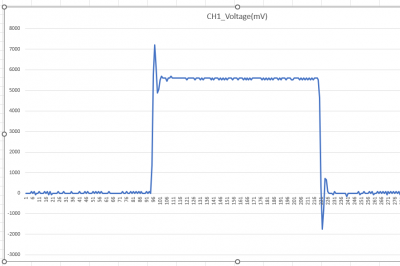Oklay, thanks all for your thoughts!
Some answers:
GARTHWILSON wrote:
...it's bouncing enough to change states again, long before the processor or something like a VIA would be ready for the next edge:
and
BigEd wrote:
It'd be worth zooming in to see if that really is happening. But if it is, it is indeed worth doing something about.
Here is a zoomed in graph (Sorry, I pressed the wrong button on my scope and got an excel file - so I graphed it). Perhaps I am indeed worrying too much - it probably isn't bad enough to change states. Do you agree?
Attachment:
 graph.png [ 24.19 KiB | Viewed 3136 times ]
graph.png [ 24.19 KiB | Viewed 3136 times ]
By the way, there is no board that produced this graph. The can is on the bench (okay, kitchen table!) with +5v, GND, and the scope probe attached - and I have checked the calibration of my probe.
CountChocula wrote:
One thing that might be helpful is to tell us why you’re asking. The ringing you see could just be an artifact of the way you’re measuring it (as Garth mentioned), and so it isn’t necessarily something worth worrying about unless it’s causing problems.
I ask because I have been having problems with the SBC that this oscillator is normally part of. (See:
viewtopic.php?f=4&t=2029). Before I take it all apart and start again I was casting around for other possible causes of the wierdness I am getting with interrupts. I decided to start a newbie thread as a) I am a newbie in this area (analogue electronics) and b) I thought it sufficiently off topic to start another thread.
BigEd wrote:
-snip-
Slowing down the edges will help, as will having good ground return.
-snip-
Also, it will matter what the clock is driving - what kind of load. Your clock driver should be appropriately sized for the load, so the edges are adequately fast for correct operation but not as fast as possible.
You probably won't need to add resistors at the near end or the far end, but "terminating the line" is a term that you might come across.
BigEd, please could you explain in a bit more detail (remember - analogue electronics dummy here) what you mean.
"Slowing down the edges" How?
"What its driving". It isn't driving anything as per the graphs above - the can is powered and has a scope lead on the output - it normally drives a 65C02, 65C22 and 65C51.
"You probably won't need to add resistors..." I read an exchange between someone here and an expert (I forget the name) that went into series resistors but firstly, I didn't fully understand a lot of it and secondly, they didn't go into a lot of explanation. Could you explain how its done and why please.







